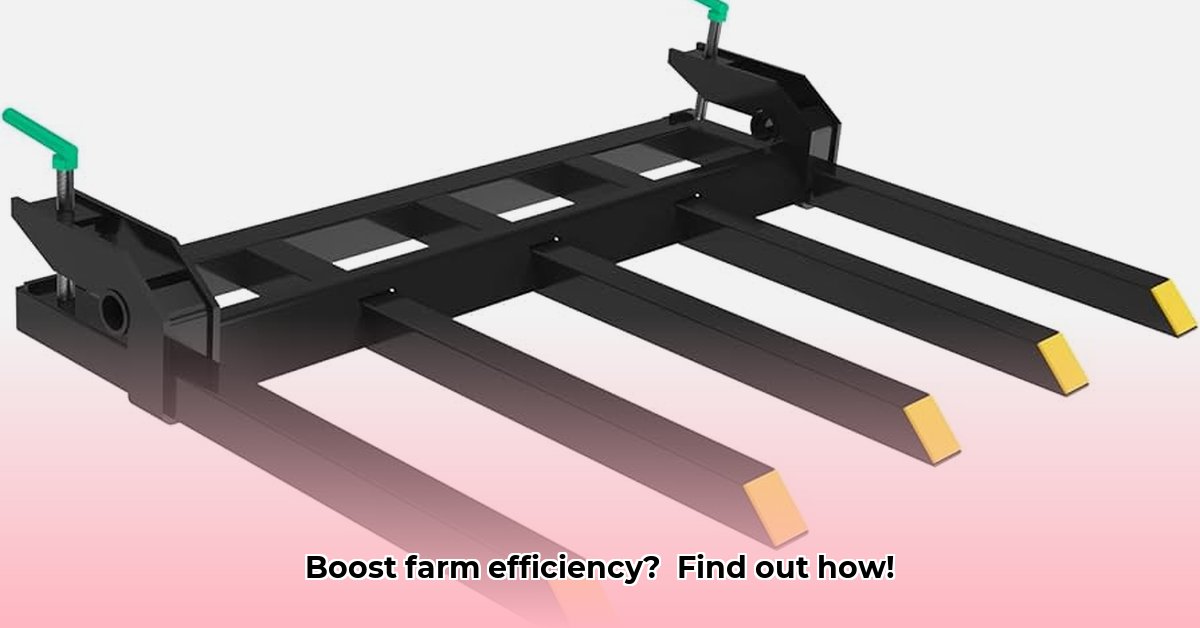
Understanding Clamp-On Tractor Forks: A Versatile Farm Tool
Are you looking to streamline your farm operations and boost efficiency without breaking the bank? Clamp-on tractor forks offer a cost-effective solution for handling a wide variety of materials, from hay bales to pallets of fertilizer. These attachments directly mount to your tractor's loader, providing significant flexibility. Unlike integrated forks, they're easily detachable, allowing you to quickly switch between different implements as needed. This adaptability makes them particularly beneficial for smaller farms juggling multiple tasks. For more detailed information, check out this helpful resource on clamp-on forks. However, this convenience comes with some trade-offs. Clamp-on forks typically have a lower weight capacity than integrated forks and may slightly reduce visibility due to the clamping mechanism. Careful consideration of your typical loads and selection of appropriately rated forks are crucial for safe operation. Choosing the right forks involves a personalized approach, considering several key factors.
Choosing the Right Clamp-On Tractor Forks: A Personalized Approach
Selecting the ideal clamp-on tractor forks requires careful consideration of your specific needs and operating conditions. Here's a breakdown of the key factors to consider:
Weight Capacity: This is paramount. Underestimating your lifting needs can lead to equipment damage or, worse, accidents. Determine the heaviest load you'll handle and choose forks with a significantly higher weight rating as a safety margin. Common ratings range from 1500 lbs to 4000 lbs, but heavier-duty options are available.
Compatibility with Your Tractor: Ensure complete compatibility with your tractor's loader. Check manufacturer specifications to avoid costly mistakes and safety risks. An ill-fitting attachment is a serious hazard.
Fork Length: This affects both carrying capacity and maneuverability. Longer forks handle larger payloads but are less agile in tight spaces. Shorter forks offer better maneuverability but have a lower capacity. The best length depends on your typical tasks and working environment.
Safety Features: Prioritize models with safety features like integrated lighting for improved visibility, especially in low-light conditions, and additional structural bracing for enhanced stability. These additions significantly reduce accident risks.
A Step-by-Step Guide to Safe Operation
Safe and efficient operation of clamp-on tractor forks requires careful adherence to best practices. Follow these steps for optimal results and minimized risk:
Thorough Inspection: Before attachment, inspect both the forks and your tractor's loader for any damage or wear. Confirm that the intended load weight is well within the safe operating capacity.
Secure Attachment: Carefully attach the forks to the loader, following the manufacturer's instructions precisely. Double-check all connections for stability. A loose connection poses a serious safety risk.
Smooth Lifting: Lift the load smoothly, avoiding abrupt movements. Maintain a steady pace and be constantly aware of your surroundings.
Precise Positioning: Position the load accurately and avoid sudden movements that could cause instability or tipping.
Controlled Lowering: Lower the load slowly and carefully, ensuring a stable placement. Avoid dropping the load.
Safe Removal and Storage: After use, detach the forks according to manufacturer instructions and store them properly to prevent damage.
Weighing the Pros and Cons: Making an Informed Decision
The decision to use clamp-on tractor forks involves weighing their advantages against their limitations. Here's a comparison:
| Feature | Advantages | Disadvantages |
|---|---|---|
| Cost | Significantly cheaper than integrated forks. | Lower weight capacity than integrated forks. |
| Versatility | Easily interchangeable with other attachments. | May slightly reduce visibility compared to built-in options. |
| Maintenance | Typically easy to maintain and clean. | Clamping mechanism is subject to wear and tear. |
| Storage | Relatively compact storage when not in use. | Might require dedicated storage space depending on size. |
Safety First: Essential Precautions and Best Practices
Prioritizing safety is paramount. Never exceed the weight limit of your forks. Maintain a stable base and footing, especially when handling heavy materials. Use additional lighting or a spotter in low-visibility situations. Regular inspection for wear and tear is crucial to prevent accidents. Always consult your tractor's operator's manual and relevant safety regulations.
Additional Considerations for Small Sustainable Farms
For small sustainable farms, the frequency of use plays a crucial role in choosing the right forks. Infrequent use might justify clamp-on forks' affordability, but frequent use necessitates the enhanced safety and performance of quick-attach systems. Prioritize maneuverability and visibility, especially in constrained spaces. Regular inspection and maintenance are crucial for extending the lifespan and ensuring safe operation. Consider seeking advice from experienced farmers or agricultural equipment specialists. Thorough research and careful consideration of your specific needs will ensure you make the best decision for your farm's long-term success.